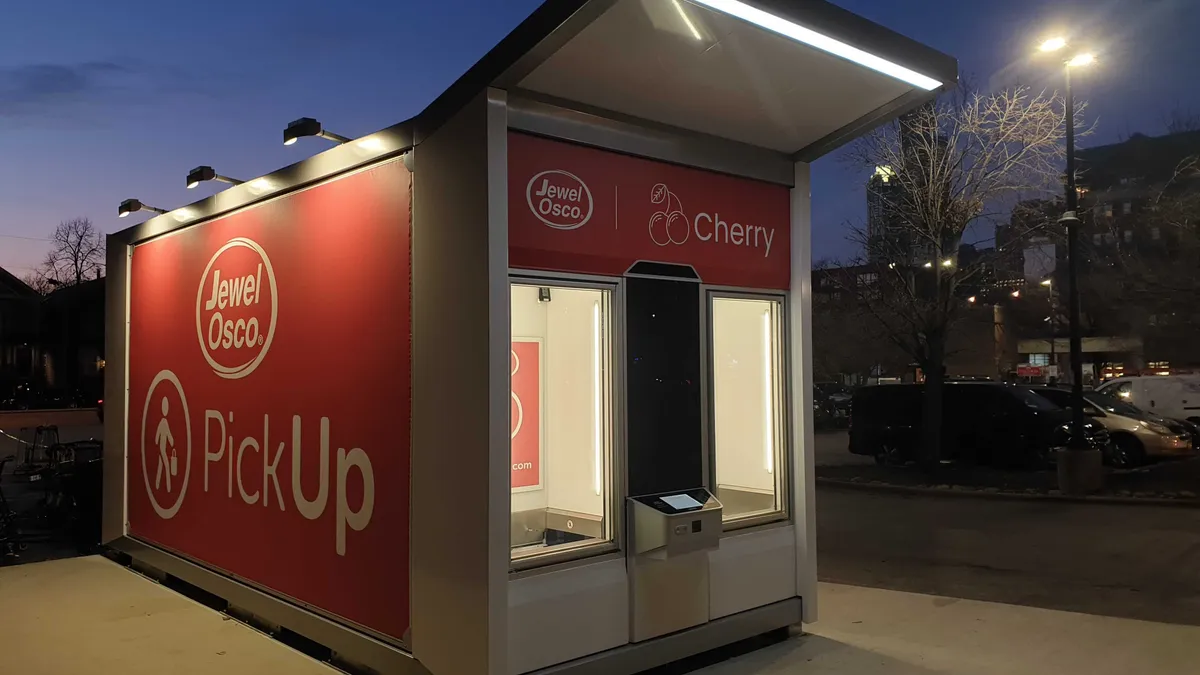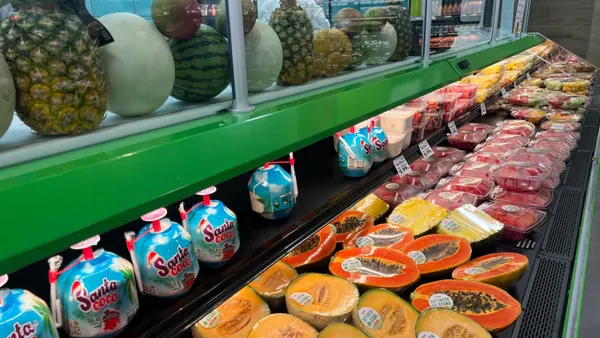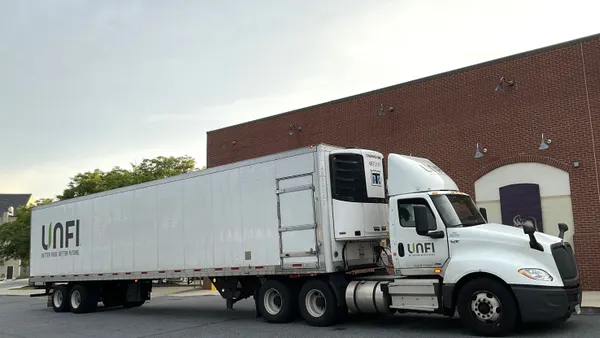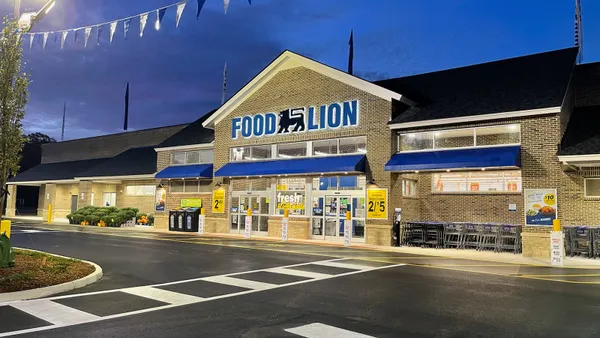Pardon the Disruption is a column that looks at the forces shaping food retail.
When it comes to online shopping, the grocery industry tends to think in terms of its two main services: store pickup and delivery. But there’s a third option, often overlooked in the past, that combines both capabilities and promises to bring a new kind of convenience to e-commerce.
I like to think of it as “third-place” pickup. It’s where shoppers pick up an order from a locker or automated kiosk located near to where they work, live or commute. This could be a library, an office building, a park or just outside a fueling station. It’s a helpful service for time-pressed shoppers who don’t want to swing by a store but also aren’t around — or don’t feel like paying the high delivery fees — for home delivery.
This is not a new concept. Amazon has placed package pickup lockers across the country — everywhere from apartment buildings to 7-Elevens and, yes, grocery stores. In France and in other European countries, grocers have spent years delivering to pickup points for rural and suburban shoppers to collect.
Grocers across the U.S., including Albertsons and Stop & Shop, have also added lockers and automated kiosks to their parking lots and store lobbies, helping them and their customers get more comfortable with the technology.
But the remote model seems to be gaining new urgency as shoppers become increasingly comfortable with online shopping and grocers look for new ways to offer convenience. Kroger is trialing pickup from remote locations near Cincinnati, where it's based, while innovative regional grocer Lowes Foods recently placed its first pickup kiosk inside the main offices of retail automation firm Bell and Howell in Durham, North Carolina. In Europe, a new concept called Delipop will allow each store to pick up orders from multiple retailers inside automated vending machines. It plans to open more than 500 locations over the next several years.
For an office worker who wants to get home to their family but still needs daily essentials, being able to pick up groceries from the lobby of their office building before heading home could be a revelation. Ditto for an exhausted hospital worker at the end of a shift.
Pickup points also offer shoppers the flexibility of being able to gather their groceries when they want, without worrying about service windows.
“Retailers are fighting for expanding or defending share of wallet and offering pickup locations away from the store provides access to a potential customer base that may be outside of the radius of their store,” Scott DeGraeve, vice president of MFC solutions at AutoStore and a former executive with online grocer Peapod, told me.
In addition to offering another convenient shopping option, pickup spots can serve as de facto stores in underserved communities where the cost of building a full brick-and-mortar shop may not be economically feasible. It’s also a way of hitting back against dollar stores as they ramp up their grocery assortment in many of these communities across the U.S.
This seems to be the approach Kroger is taking with its Hometown Pickup program that launched earlier this year and now has 14 grocery pickup points in Ohio and 18 in Kentucky, according to a company spokesperson. These include towns like Dry Ridge, Kentucky, and Owensville, Ohio. When Kroger launched the initiative during its investor conference this spring, it positioned the service as a way to reach rural communities without many grocery options.
At least one independent operator, Ramsey’s Market in Iowa, is taking a similar approach. Owner Theo Ramsey calls the lockers he began stocking earlier this summer, which offer 15 refrigerated and 15 frozen storage units in total, “P.O. boxes for groceries.”
“This is just our answer in trying to bring groceries back, fresh food back to rural communities that don't have a grocery store,” Ramsey said in a recent interview with my colleague, Catherine Douglas Moran.
Community lockers and kiosks also come with efficiency benefits, like the ability to drop multiple orders at a single spot, which can save on fuel and labor costs.
And then there’s the pure marketing value of pickup points. Emblazoned with a grocer’s logo, these spots can serve as billboards reminding customers not just of their brand but of their focus on convenience, as well.
“Retailers are fighting for expanding or defending share of wallet and offering pickup locations away from the store provides access to a potential customer base that may be outside of the radius of their store."

Scott DeGraeve
Vice president of MFC solutions, AutoStore
New processes and picking the right locations
Pickup points can expand a grocer’s service area. They also make good on that promise so many are now making of serving customers anywhere, at any time.
But there are operational complexities that will challenge grocers’ ability to deploy and scale this innovative service. Jason Soar, a former grocery e-commerce lead for Sainsbury's in the U.K. and now CEO of consulting company ThinkThru, said the cost of building, running and maintaining pickup points typically offset the savings that come from batching orders. This includes the hardware costs of lockers that include refrigeration and freezer technology, or kiosks that incorporate pricey automation on top of that. It also includes software costs, including the tricky steps involved in syncing up new pickup points with existing e-commerce technology, said DeGraeve, who oversaw the rollout of Peapod pickup lockers at Washington, D.C., Metro stations in 2016.
“You have to implement a new process to deliver orders to these locations, and a new process to ensure that it’s clear to the user exactly what to do when they arrive,” DeGraeve said.
This puts a lot of pressure on driving volume to pickup points, making savvy site selection a must. Soar said grocers need to be looking for spots shoppers will be frequenting or that will add value to their trip, but that aren’t in close proximity to other full-service grocery stores. He cited gas stations and restaurants as examples. For office workers, train stations and bus stops could also become convenient pickup points.
Grocers also have to figure out just how fast they want to get orders to customers. The most efficient approach is a next-day model, which allows grocers to gather multiple orders and shuttle them out to pickup points in what might be just one daily trip. But consumers have gotten used to same-day service for both delivery and store pickup, and many may not be willing to wait a day to get their groceries.
Retailers can achieve better economics with a next-day service and risk turning off speed-sensitive shoppers. Or they can offer faster fulfillment times but add cost to the model. As with so many other digital initiatives, pickup points come with some difficult tradeoffs when you peel back the curtain.
Whichever model they choose, retailers should look at partnerships to help manage the service. Partnering with a logistics firm to service pickup points could dilute margins, though it would offload the complicated and costly last mile, said DeGraeve. Retailers should also look to the organizations that benefit from pickup points to defray some of the cost of installing kiosks or lockers. Companies and office building landlords, for example, might want to offer grocery pickup as a perk to bring workers back to their desks and would likely be willing to pay up.
Aside from cost and logistical considerations, grocers also need to think hard about customer service. Remote pickup locations don’t have a store worker or delivery driver to address missing items or check on substitutions. That means companies will need to have some sort of live support feature, which could happen by phone or via two-way intercom at the pickup site, and processes in place to manage errors.
Imprecise order fulfillment could really be painful here. If a shopper gets a wrong product or a bad substitution in their bag, the grocer will likely have no choice but to offer a refund, which could get very expensive, said Soar.
DeGraeve knows all too well the perils of rolling out pickup points. Peapod’s locker rollout to D.C. Metro stations didn’t advance past the pilot phase, and the company never tried a similar service again before folding into Ahold Delhaize’s operations last year. He said building awareness for the service was difficult, and the costs, including staffing each locker bank with an employee, quickly piled up.
But that doesn’t prevent him from encouraging retailers to offer a similar service today. Locker and kiosk technology has advanced to the point where they can operate autonomously, he said. And many more shoppers are using e-commerce today than were back in 2016.
“I think it will be a slower, gradual rollout over the coming years as grocers figure out how to cost-effectively provide these remote pickup options and make it a convenient experience that the consumer really wants," DeGraeve said.











